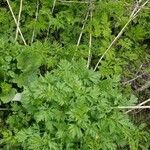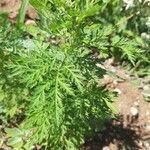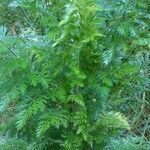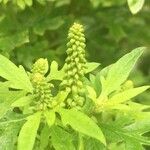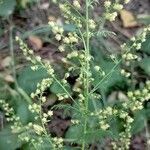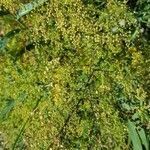Annuals, 30–200(–300) cm, sweetly aromatic. Stems mostly 1, erect, green, turning to reddish brown with age, simple (smooth or ribbed), glabrous or sparsely hairy. Leaves cauline, bright green; blades triangular to broadly ovate, 2–5(–10) × 2–4 cm, 2–3-pinnatifid (lobes relatively narrow, ± toothed), faces glabrous, gland-dotted. Heads (nodding, peduncles 2–5 mm) in open, (diffusely branched, leafy) arrays 15–30(–40) × 10–20 cm. Involucres globose, 1.5–2.5 × 1.5–2.5 mm. Phyllaries (green) lanceolate, glabrous. Florets: pistillate (0–)10–20; bisexual 18–24; corollas pale yellow (broadly campanulate), 0.5–1 mm, glabrous. Cypselae oblong (flattened), 0.3–0.8 mm, glabrous. 2n = 18.
Sweet-scented glabrous annual 3–30 dm, usually bushy-branched; lvs 2–10 cm, mostly twice or thrice pinnatifid, the ultimate segments linear or lanceolate, sharply toothed; infl broad and open, panicle-like, the heads loose, often nodding, on evident short peduncles; invol glabrous, 1–2 mm; achenes narrowly turbinate, obscurely or scarcely nerved; 2n=18. Fields and waste places; native to Asia and e. Europe, now naturalized in N. Amer., especially in e. and c. U.S. and adj. Can. Aug.–Nov. Source of a potentially important antimalarial drug, artemisinin.
A large annual herb. The stems are upright and often red. It can grow 1.6 m tall. The leaves are finely divided with leaflets along the stalk and teeth along the edge. The flowers are small and yellow and are in loose clusters.
